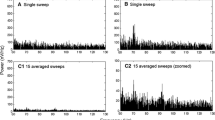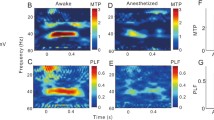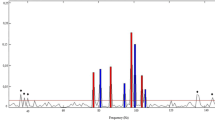Abstract
Delivering auditory stimuli at a rate of approximately 40 per s produces an electrical cerebral response which can be recorded from the scalp. This response, called the 40-Hz auditory steady state response (40-Hz ASSR), consists of a sinusoidal waveform that has the same frequency as that of stimulus delivery [7,11,16,22] (Fig. 1). Recent evidence suggests that the 40-Hz ASSR may offer a way to monitor the level of consciousness during anesthesia. The amplitude of the 40-Hz ASSR was reduced to noise level during anesthesia with isoflurane 1% end-tidal in oxygen [15]. The amplitude remained maximally reduced after decreasing the concentration of the isoflurane to 0.5% end-tidal in oxygen and allowing 10 min for equilibration [15]. The amplitude of the 40-Hz ASSR was also maximally reduced by enflurane 0.5%, 0.8%, or 1.1% and 60% N20 (end-tidal concentrations) [25]. The return of the ability to open the eyes on command after termination of the anesthetic seemed reliably associated with a clear, stepwise increase in the amplitude of the 40-Hz ASSR, which until then had remained markedly reduced [15,25]. This suggests that the profound attenuation of the 40-Hz ASSR by enflurane-N20 or isoflurane may reflect unconsciousness (unresponsiveness to verbal command). Additional evidence that the attenuation of the 40-Hz ASSR reflects unconsciousness was obtained during induction of anesthesia with thiopental [15], propofol (unpublished observations), or sufentanil [14]. With these agents, profound attenuation of the 40-Hz ASSR and unresponsivenes to verbal command occurred at the same time.
Access this chapter
Tax calculation will be finalised at checkout
Purchases are for personal use only
Preview
Unable to display preview. Download preview PDF.
Similar content being viewed by others
References
Arnst DJ (1985) Presbycusis. In: Katz J (ed) Handbook of clinical audiology, 3rd edn. Williams and Wilkins, Baltimore, pp 707–720
Beauchamp KG, Yuen CK (1992) Digital methods for signal analysis. Allen and Unwin, London
Chiappa KH (1990) Evoked potentials in clinical medicine, 2nd edn. Raven, New York
Cohen BA, Sances A (1977) Stationarity of the human electroencephalogram. Med Biol Eng Comput 15:513–518
Cooley JW, Tukey JW (1965) An algorithm for the machine calculation of complex Fourier series. Math Comp pp 297–301
Firsching R, Luther J, Eidelberg E, Brown WE Jr, Story JL, Boop FA (1987) 40 Hz - middle latency auditory evoked response in comatose patients. Electroencephalogr Clin Neurophysiol 67:213–216
Galambos R, Makeig S, Talmachoff PJ (1981) A 40-Hz auditory potential recorded from the human scalp. Prac Natl Acad Sei USA 78:2643–2647
Gotman J (1992) The use of computers in analysis and display of EEG and evoked potentials. In: Daly DD, Peddley TA (eds) Current practice of clinical electroencephalography, 2nd edn. Raven, New York, pp 51–83
Hari R, Hamalainen M, Joutsiniemi SR (1989) Neuromagnetic steady state response to auditory stimuli. J Acoust Soc Am 86:1033–1039
Makela JP, Hari R (1987) Evidence for cortical origin of the 40 Hz auditory evoked response in man. Electroencephalogr Clin Neurophysiol 66:539–546
Picton TW (1987) Human auditory steady-state responses. In: Barber C, Blum T (eds) Evoked potentials III. Butterworths, Toronto, pp 117–124
Picton TW (1990) Auditory evoked potentials. In: Daly DD, Pedley TA (eds) Current practice of clinical electroencephalography, 2nd edn. Raven, New York pp 625–678
Plourde G (1991) Depth of anaesthesia. Can J Anaesth 38:270–274
Plourde G, Boylan JF (1991) The auditory steady state response during sufentanil anaesthesia. Br J Anaesth 66:683–691
Plourde G, Picton TW (1990) Human auditory steady-state response during general anesthesia. Anesth Analg 71:460–468
Plourde G, Stapells DR, Picton TW (1991) The human auditory steady-state evoked potentials. Acta Otolaryngol Suppl (Stockh) 491:153–160
Press WH, Flannery BP, Teukolsky SA, Vetterling WT (1988) Numerical recipes in C. The art of scientific computing. Cambridge University Press, Cambridge
Putnam LE, Johnson R, Roth WT (1992) Guidelines for reducing the risk of disease transmission in the psychophysiology laboratory. Psychophysiology 29:127–141
Regan D (1989) Human brain electrophysiology. Evoked potentials and evoked magnetic fields in science and medicine. Elsevier, New York
Rodriguez R, Picton TW, Linden D, Hamel G, Laframboise G (1986) Human auditory steady state responses: effects of intensity and frequency. Ear Hear 7:300–313
Shannon CE (1948) A mathematical theory of communication. Bell System Tech J 27:623–656
Stapells DR, Linden D, Suffield JB, Hamel G, Picton TW (1984) Human auditory steady state potentials. Ear Hear 5:105–113
Starr A, Don M (1992) Brain potentials evoked by acoustic stimuli. In: Picton TW (ed) Human event-related potentials. Elsevier, New York, pp 97–155
Thornton C (1991) Evoked potentials in anaesthesia. Eur J Anaesthesiol 8:89–107
Villemure C, Plourde G, Castillo O (1991) The 40 Hz auditory steady-state response for monitoring the level of consciousness. Anesth Analg 74: S3 36 (abstract)
Editor information
Editors and Affiliations
Rights and permissions
Copyright information
© 1994 Springer-verlag Berlin Heidelberg
About this chapter
Cite this chapter
Villemure, C., Plourde, G., April, P. (1994). The 40-Hz Auditory Steady State Response for Monitoring Level of Consciousness: Methodological Considerations. In: Schulte am Esch, J., Kochs, E. (eds) Central Nervous System Monitoring in Anesthesia and Intensive Care. Springer, Berlin, Heidelberg. https://doi.org/10.1007/978-3-642-78441-5_14
Download citation
DOI: https://doi.org/10.1007/978-3-642-78441-5_14
Publisher Name: Springer, Berlin, Heidelberg
Print ISBN: 978-3-642-78443-9
Online ISBN: 978-3-642-78441-5
eBook Packages: Springer Book Archive




